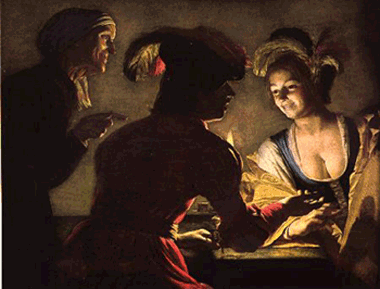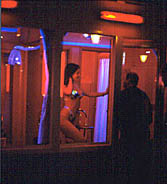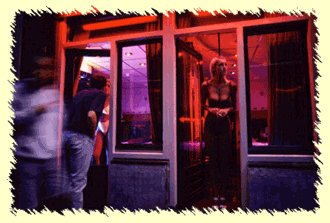VISIT THE NETHERLANDS...WHORES AND DRUGS FOR THE WHOLE FAMILY!
Amsterdam - The Red Light District wants to boost its image as a tourist friendly and safe place to visit. Although this area is visited by approximately 100,000 people a day (of which around 3,000 visit one of the girls) (Uhh...I didn't really need to know that, but since I know, there are a lot of lonely sick men...) many regard this district as dangerous. Looking at crime numbers though, the Red Light District doesn't stand out.
Of course, like in any major city, so many people in such a relatively small area, also attracts criminal activity. But by no means is this a crime district. And since this area thrives on tourism, much in done to ensure their safety. (This sounds like some left over marketing safety material for Aruba.)

To encourage people to take a look themselves, Mariska Majoor (founder of the Prostitution Information Centre) organized an "open day" in the area. For one day a lot of the clubs, museums, businesses and organizations opened their doors (free of charge). Now everyone had an alibi to be in the Red Light District. And many people came (to the area that is). Even some of the prostitutes showed their rooms and answered questions and a queue formed in front of the Bananenbar. And as far as the "business" is concerned, this never stops. So most of the women working today (they complained about the lack of "business" though).
Amsterdam started to flourish late 14th and 15th century. The fast growth formed the foundation for the "Golden Age". In the Middle Ages, Amsterdam was a city of stone monasteries and wooden houses. Only a few of these buildings still exist. The main ones are the "Old Church" (around which the red light district developed) and the "New Church". The "New Church" is located at Dam Square and the "Old Church" in the middle of what is now the Red Light District.

At the end of the 17th century Amsterdam was widely known in Europe for it's many "houses of pleasure". In these luxury brothels (tolerated in the red light district) one could enjoy music, dance and the company of common prostitutes. Through the ages, authorities tried to control prostitution to limit nuisance and prevent exploitation.
Depending on the morality of the time, different solutions were used. In the middle ages prostitution was not so much considered to be a moral issue. Although is was considered as dishonesty (literally: without honor) it was also seen as an indispensable phenomenon. So it was tolerated. Prostitutes had a dress code and were not allowed to be married. It was prohibited for married men to visit prostitutes and prostitution was confined to certain spots in the city (this later became The Red Light District).
In the 16th and 17th century the influence of the Church on governmental policies increased. Sins became crimes and repression was on the rise. In spite of prohibition and sometimes hard punishments prostitution thrived in the prosperous trade city Amsterdam Prostitution remained small-scale and prostitutes worked for madams, frequently former prostitutes, for board and logging and to pay off working clothes and make-up. If they stayed out of trouble, madams would not be bothered by the town governing authorities.
In the 18th century regulations became less strict. Owners of dancing rooms were allowed to expand their businesses and prostitutes started working in these places. This way the whole business was out of the public eye. During the time Napoleon ruled Holland, health concerns were more important than morality. To prevent loosing soldiers to syphilis, prostitutes were forced to have health checks twice a week.
Paid sex was seen as a necessary evil. Sexual abstention would lead to depression and little zest for life. The testing remained after the French period. However the pragmatic approach towards prostitution changed. It was seen as "legalized sexual abuse" and this stricter morality led to a law in 1911, banning brothels. Although prostitution diminished, an article of law was not enough to ban it.

Behind the facades of decent companies such as massage salons, art trades and tobacco shops, clandestine brothels thrived. The authorities quickly realized that it was impossible to enforce the law in the area around the Old Church, the old prostitution district. So an unofficial policy of tolerating this business was adopted. As long as the women worked inside and were not standing in the door openings they could do their business. Women made potential customers aware of their presence thru a small opening between the curtains and a soft knock on the window.
As the years went by the curtains opened more and more. And with the less strict sexual morality of the sixties and seventies the tolerance towards prostitution increased even more. In the year 2000 prostitution was legalized. The main objective of this new law is to prevent forced prostitution and exploitation of women. (prevent exploitation????)
The red light district has always been the center of erotic entertainment in Amsterdam.

Of course, like in any major city, so many people in such a relatively small area, also attracts criminal activity. But by no means is this a crime district. And since this area thrives on tourism, much in done to ensure their safety. (This sounds like some left over marketing safety material for Aruba.)

To encourage people to take a look themselves, Mariska Majoor (founder of the Prostitution Information Centre) organized an "open day" in the area. For one day a lot of the clubs, museums, businesses and organizations opened their doors (free of charge). Now everyone had an alibi to be in the Red Light District. And many people came (to the area that is). Even some of the prostitutes showed their rooms and answered questions and a queue formed in front of the Bananenbar. And as far as the "business" is concerned, this never stops. So most of the women working today (they complained about the lack of "business" though).
Amsterdam started to flourish late 14th and 15th century. The fast growth formed the foundation for the "Golden Age". In the Middle Ages, Amsterdam was a city of stone monasteries and wooden houses. Only a few of these buildings still exist. The main ones are the "Old Church" (around which the red light district developed) and the "New Church". The "New Church" is located at Dam Square and the "Old Church" in the middle of what is now the Red Light District.

At the end of the 17th century Amsterdam was widely known in Europe for it's many "houses of pleasure". In these luxury brothels (tolerated in the red light district) one could enjoy music, dance and the company of common prostitutes. Through the ages, authorities tried to control prostitution to limit nuisance and prevent exploitation.
Depending on the morality of the time, different solutions were used. In the middle ages prostitution was not so much considered to be a moral issue. Although is was considered as dishonesty (literally: without honor) it was also seen as an indispensable phenomenon. So it was tolerated. Prostitutes had a dress code and were not allowed to be married. It was prohibited for married men to visit prostitutes and prostitution was confined to certain spots in the city (this later became The Red Light District).
In the 16th and 17th century the influence of the Church on governmental policies increased. Sins became crimes and repression was on the rise. In spite of prohibition and sometimes hard punishments prostitution thrived in the prosperous trade city Amsterdam Prostitution remained small-scale and prostitutes worked for madams, frequently former prostitutes, for board and logging and to pay off working clothes and make-up. If they stayed out of trouble, madams would not be bothered by the town governing authorities.
In the 18th century regulations became less strict. Owners of dancing rooms were allowed to expand their businesses and prostitutes started working in these places. This way the whole business was out of the public eye. During the time Napoleon ruled Holland, health concerns were more important than morality. To prevent loosing soldiers to syphilis, prostitutes were forced to have health checks twice a week.
Paid sex was seen as a necessary evil. Sexual abstention would lead to depression and little zest for life. The testing remained after the French period. However the pragmatic approach towards prostitution changed. It was seen as "legalized sexual abuse" and this stricter morality led to a law in 1911, banning brothels. Although prostitution diminished, an article of law was not enough to ban it.

Behind the facades of decent companies such as massage salons, art trades and tobacco shops, clandestine brothels thrived. The authorities quickly realized that it was impossible to enforce the law in the area around the Old Church, the old prostitution district. So an unofficial policy of tolerating this business was adopted. As long as the women worked inside and were not standing in the door openings they could do their business. Women made potential customers aware of their presence thru a small opening between the curtains and a soft knock on the window.
As the years went by the curtains opened more and more. And with the less strict sexual morality of the sixties and seventies the tolerance towards prostitution increased even more. In the year 2000 prostitution was legalized. The main objective of this new law is to prevent forced prostitution and exploitation of women. (prevent exploitation????)
The red light district has always been the center of erotic entertainment in Amsterdam.










1 comment:
Your pictures with the prositutes in the windows in Amsterdam is right-on. We visited Amsterdam many, many years ago to see tulips. To our surprise the bus tour we took also thought it would be good to make a stop in the red light district and window shop. What a sick idea that was. I'm sure Aruba thinks nothing of there prostution either. How Sick!!!!
Post a Comment